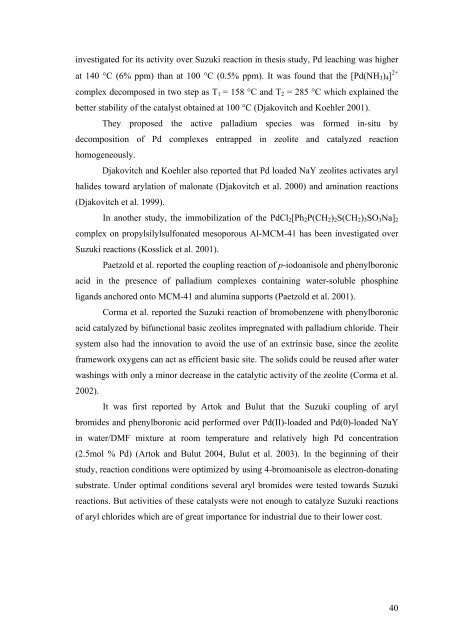chapter 2 palladium catalysts in suzuki cross- coupling reaction
chapter 2 palladium catalysts in suzuki cross- coupling reaction
chapter 2 palladium catalysts in suzuki cross- coupling reaction
You also want an ePaper? Increase the reach of your titles
YUMPU automatically turns print PDFs into web optimized ePapers that Google loves.
<strong>in</strong>vestigated for its activity over Suzuki <strong>reaction</strong> <strong>in</strong> thesis study, Pd leach<strong>in</strong>g was higher<br />
at 140 °C (6% ppm) than at 100 °C (0.5% ppm). It was found that the [Pd(NH3)4] 2+<br />
complex decomposed <strong>in</strong> two step as T1 = 158 °C and T2 = 285 °C which expla<strong>in</strong>ed the<br />
better stability of the catalyst obta<strong>in</strong>ed at 100 °C (Djakovitch and Koehler 2001).<br />
They proposed the active <strong>palladium</strong> species was formed <strong>in</strong>-situ by<br />
decomposition of Pd complexes entrapped <strong>in</strong> zeolite and catalyzed <strong>reaction</strong><br />
homogeneously.<br />
Djakovitch and Koehler also reported that Pd loaded NaY zeolites activates aryl<br />
halides toward arylation of malonate (Djakovitch et al. 2000) and am<strong>in</strong>ation <strong>reaction</strong>s<br />
(Djakovitch et al. 1999).<br />
In another study, the immobilization of the PdCl2[Ph2P(CH2)2S(CH2)3SO3Na]2<br />
complex on propylsilylsulfonated mesoporous Al-MCM-41 has been <strong>in</strong>vestigated over<br />
Suzuki <strong>reaction</strong>s (Kosslick et al. 2001).<br />
Paetzold et al. reported the coupl<strong>in</strong>g <strong>reaction</strong> of p-iodoanisole and phenylboronic<br />
acid <strong>in</strong> the presence of <strong>palladium</strong> complexes conta<strong>in</strong><strong>in</strong>g water-soluble phosph<strong>in</strong>e<br />
ligands anchored onto MCM-41 and alum<strong>in</strong>a supports (Paetzold et al. 2001).<br />
Corma et al. reported the Suzuki <strong>reaction</strong> of bromobenzene with phenylboronic<br />
acid catalyzed by bifunctional basic zeolites impregnated with <strong>palladium</strong> chloride. Their<br />
system also had the <strong>in</strong>novation to avoid the use of an extr<strong>in</strong>sic base, s<strong>in</strong>ce the zeolite<br />
framework oxygens can act as efficient basic site. The solids could be reused after water<br />
wash<strong>in</strong>gs with only a m<strong>in</strong>or decrease <strong>in</strong> the catalytic activity of the zeolite (Corma et al.<br />
2002).<br />
It was first reported by Artok and Bulut that the Suzuki coupl<strong>in</strong>g of aryl<br />
bromides and phenylboronic acid performed over Pd(II)-loaded and Pd(0)-loaded NaY<br />
<strong>in</strong> water/DMF mixture at room temperature and relatively high Pd concentration<br />
(2.5mol % Pd) (Artok and Bulut 2004, Bulut et al. 2003). In the beg<strong>in</strong>n<strong>in</strong>g of their<br />
study, <strong>reaction</strong> conditions were optimized by us<strong>in</strong>g 4-bromoanisole as electron-donat<strong>in</strong>g<br />
substrate. Under optimal conditions several aryl bromides were tested towards Suzuki<br />
<strong>reaction</strong>s. But activities of these <strong>catalysts</strong> were not enough to catalyze Suzuki <strong>reaction</strong>s<br />
of aryl chlorides which are of great importance for <strong>in</strong>dustrial due to their lower cost.<br />
40

















